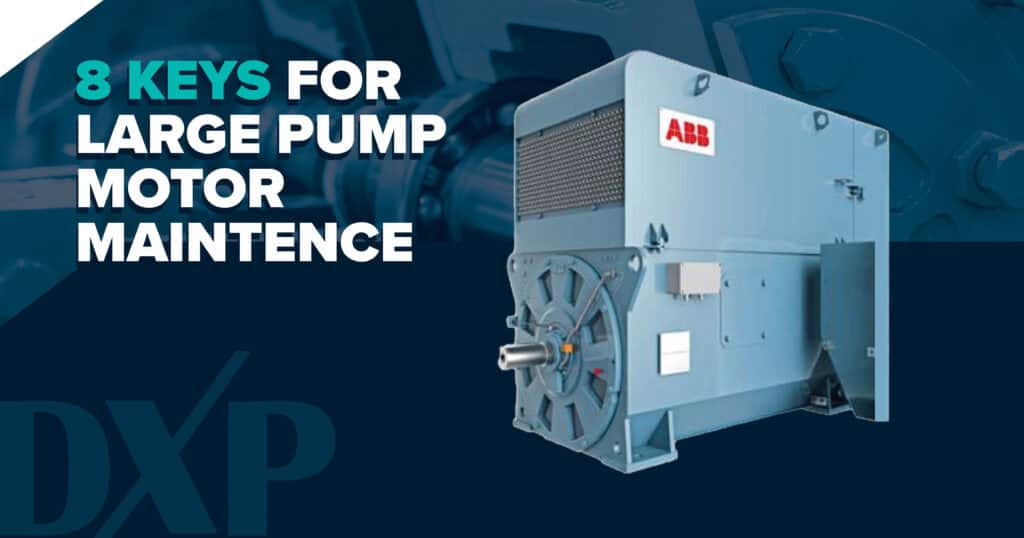Large pump motors are essential for the performance and reliability of many industrial systems. Whether driving critical water systems, chemical processes, or oil and gas applications, these motors endure demanding conditions that require proactive care. Effective maintenance not only extends equipment life but also prevents costly downtime and unexpected failures. Below are key strategies to keep large pump motors running smoothly and efficiently:
1. Prioritize thermal management.
Large pump motors generate substantial heat during operation. Overheating is a primary failure mode—thermal stress breaks down insulation, damages bearings, and can warp internal components. Install reliable temperature sensors at stator windings and bearings, and ensure your cooling system—fans, heat exchangers, or liquid cooling—is clean and fully functional. Regularly check cooling vents for blockage, verify coolant flow rates, and inspect fan blades for damage or imbalance. Addressing thermal issues early extends motor longevity and performance.
2. Implement vibration monitoring.
Excessive vibration is another leading cause of motor failure. It can stem from misalignment, imbalance, worn bearings, or coupling issues. Establish a scheduled vibration-analysis program—monthly or quarterly based on use intensity—to detect changes in vibration amplitude or frequency. Modern accelerometers and portable analyzers make monitoring easy; trend your vibration readings and investigate increases promptly. Installation of coupling guards is also recommended, both for safety and to minimize vibration transmission.
3. Keep lubrication in check.
Bearings rely on proper lubrication to operate smoothly. Under-lubrication causes friction and wear, while over-lubrication leads to heat buildup and seal failure. Follow manufacturer recommendations for grease type, quantity, and relubrication interval. Use clean, contaminant‑free grease guns, and always clean grease fittings before use. For sealed-for-life bearings, inspect seals and monitor operating temperature as indicators of bearing health.
4. Protect against electrical anomalies.
Power issues such as voltage imbalance, phase loss, harmonic distortion, and ground faults greatly accelerate motor wear and insulating breakdown. Periodic motor-current signature analyses (MCSA) can identify electrical irregularities before they manifest physically. Voltage and current clamp meters should check for phase symmetry and balanced load. Ensure robust motor protection—such as ground-fault relays and phase-loss detection—is in place and tested regularly.
5. Maintain clean, dry environments.
Contaminants—dust, moisture, and chemical ingress—can erode insulation and accelerate corrosion. Large pump motors often reside in harsh environments: chemical plants, wastewater treatment facilities, and outdoor pump houses. Perform routine cleaning of motor exteriors and ventilation paths. Verify enclosure integrity (especially on NEMA 4, 4X, or IP66 models), tighten bolts, and inspect seals and gaskets. When motors are idle, use desiccant breathers and keep them sealed against humidity intrusion.
6. Document and trend maintenance data.
The most significant breakthroughs in reliability come from tracking conditions over time. Maintain logs of vibration levels, bearing temperatures, lubrication records, electrical parameters, and maintenance actions. Use trending software—preferably tied into an enterprise asset management (EAM) system—to flag anomalies. Data-driven maintenance reduces downtime and guides optimal repair intervals.
7. Ensure skilled training and best practices.
A well‑trained maintenance team is vital. Conduct regular training on topics such as coupling alignment techniques, correct use of vibration tools, lubrication best practices, and electrical diagnostics. Enforce safety protocols—especially lockout/tag-out—during motor inspections and servicing. Empower technicians to report unusual readings or behaviors immediately; early detection is the linchpin of reliability.
8. Schedule preventive and predictive tasks.
Combine time-based preventive tasks—scheduled relubrication, infrared inspections, megger testing, and resonance checks—with predictive tasks, including vibration, MCSA, and oil/fatty acid analysis, for comprehensive coverage. Align these activities with key shutdowns and operational cycles to minimize disruption. And always follow OEM guidelines, customizing to the operational realities of your facility.
Maintaining large pump motors is not only a technical exercise; it’s a holistic strategy combining thermal control, vibration monitoring, lubrication discipline, electrical robustness, environmental sealing, and rigorous data tracking. Let the DXP Pacific team show you how to reduce motor failures, boost uptime, and cut life-cycle costs. Large pump motors are mission-critical assets. Treating them with the care they deserve pays dividends in reliability and profitability. Contact us today to begin.

